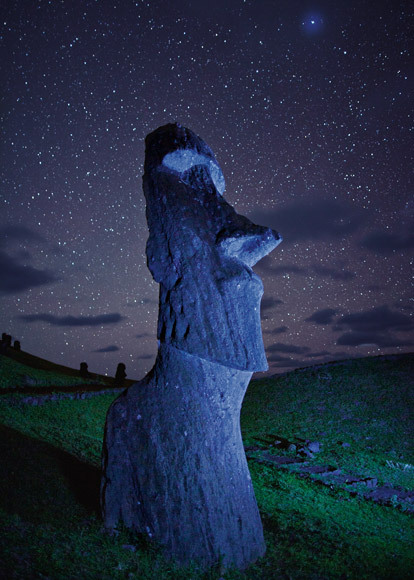Mysteries of Easter Island - death of a civilization (Part II)The loss of the Rapa Nui civilization
Mysteries of Easter Island - death of a civilization (Part II)The loss of the Rapa Nui civilization (see, http://bit.ly/1ENQBO8) has sparked a great debate amongst experts as to the real reasons for its demise. On one hand, Pulitzer Prize winning author Jared Diamond proposed that Rapa Nui extreme and wanton destruction of nature led to their downfall. On the other hand, archaeologists Terry Hunt, University of Hawaii, and Carl Lipo, California State University, are believers in the ingenuity of Rapa Nui and have argued they are examples of human resilience and endurance against all odds.John Flenley, biogeographer from Massey University, New Zealand has found pollen sediments in lakes around the island that prove that the area was once a lush forest. Jared Diamond, citing Flenley’s work, believes that once the Rapa Nui landed on the island they started cutting down trees to provide farmlands. “They had the bad luck,” Diamond argues, “to have settled in an extremely fragile island—dry, cool, and remote, which means it’s poorly fertilized by windblown dust or volcanic ash.” The agricultural yields were not enough to feed all the islanders. As more and more trees were felled for farming and canoe building, forest wood became scarce. At some point there was not enough wood to build canoes and so the islanders couldn’t go for fishing. Their food source vanishing led to a civil war and people resorted to cannibalism even before the Europeans arrived.Archaeologists Hunt and Lipo disagree with Jared Diamond’s version and have proposed a different way to explain the loss of the Rapa Nui civilization. According to them, the islanders were not actively at fault for the destruction of their home; instead it was an ecological catastrophe caused by rats. They believe that when the Rapa Nui came to the island, they bought with them rodents from the mainland. In the absence of any natural predators these rats bred prolifically and became a menace for the islanders, destroying their homes. “Feasting on palm nuts, they would have prevented the reseeding of the slow-growing trees and thereby doomed Rapa Nui forest, even if humans hadn’t been slashing and burning. No doubt the rats ate birds’ eggs too,” according to Hunt and Lipo.Finally, a team of researchers from the U.S., Chile, and New Zealand have published a third theory that competes with the other ideas. They used a technique called obsidian hydration to date Rapa Nui artifacts and constructed a timeline of these people’s lives over hundreds of years. They found population shifts occurred over time because of changing climate patterns which limited their food sources, and that took a toll on their health. According to them, the population in their weakened conditions became infected with diseases such as smallpox and syphilis that decimated their numbers. EISP researchers are striving to answer which factor contributed more towards the destruction of Rapa Nui.–RB.More about Rapa Nui: http://bit.ly/1MqvQzMhttp://bit.ly/1MoLSsVhttp://bit.ly/1KnJG2EImage: http://bit.ly/1Ii6lJV -- source link
Tumblr Blog : the-earth-story.com
#science#archaeology#easter island#rapa nui#disease#environment#ecology#canoe
